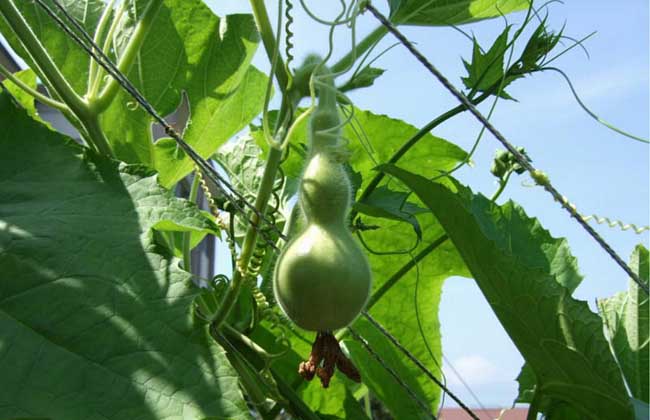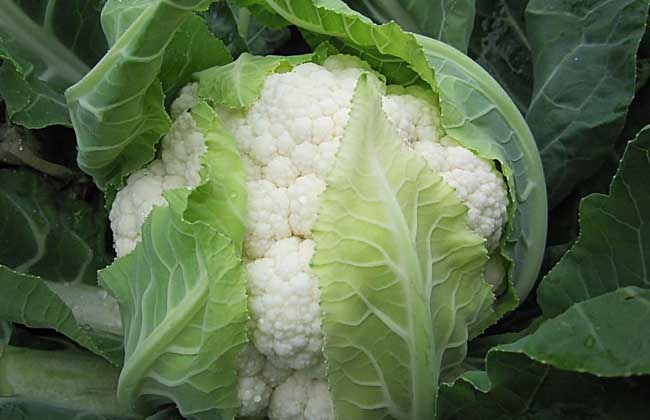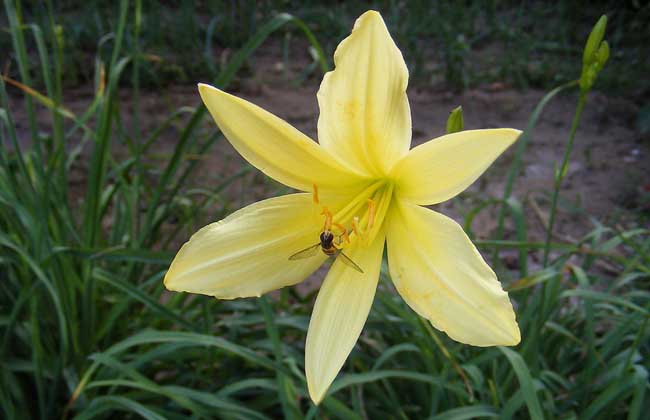High-yield planting techniques of bottle gourd

Bottle gourd, also known as bottle gourd, flat cattail, gourd, night blossom, black gourd, etc., is an annual trailing herb of the genus Cucurbitaceae. In ancient times, its mature and dry fruit shell was used as a container, and it was also used as medicine. It was cultivated all over the north and south of China, and it was widely cultivated in the south. In recent years, the north has also been introduced and cultivated. Let's take a look at the high-yield cultivation techniques of bottle gourd.
Growth environment of bottle gourd
Bottle gourd is a temperature-loving plant, the suitable temperature for growth is 20-25 ℃, it is not resistant to waterlogging and drought, drainage should be paid attention to in rainy areas, and timely irrigation should be carried out in case of drought. The seeds began to germinate at 15 ℃ and germinated fastest at 30-35 ℃. The optimum temperature for growth and fruiting stage was 20-25 ℃. The bottle gourd cannot bear the high temperature. It requires high light conditions, less disease, good growth and fruit and high yield under the condition of sufficient sunlight. Strict requirements for moisture, not resistant to early and not resistant to waterlogging. As a result, higher air humidity is required during the period. It is not resistant to barren, and it is appropriate to use humus-rich soil with strong water and fertility conservation. Nitrogen is the main nutrient, combined with appropriate amount of phosphorus and potassium fertilizer, so as to improve yield and quality.
Cultivated varieties of bottle gourd
1. Line bottle gourd: the flesh of line bottle gourd is white, about 1 cm thick, tender meat, less fiber, good quality and cooked food, strong heat resistance, not cold resistance, not resistant to waterlogging. The ability of resistance to diseases and insects is moderate.
2. Long bottle gourd: the fruit of long bottle bottle is cylindrical, 40cm long and 50cm long, with light green skin, white pulp, soft and good quality. the fruit is precocious and often bears on the vine or lateral vine.
3. Noodle gourd: noodle gourd fruit is similar in length, thickness, stalk, thin pericarp, light green, glossy, meat thick and tender, white, single melon weighs 1.5-2.0 kg, resistant to aging and precocious.
4. Big gourd: big gourd has white flesh, dense texture, more moisture, less fiber, slightly sweet taste, better quality, tender melon for cooked food, old melon can be used as receptacle, heat-resistant, cold-resistant, drought-resistant, fertilizer-loving.
5. Xiaogan bottle gourd: Xiaogan gourd fruit is cylindrical, thin peel, green, thick and white meat, few seeds and good quality. The weight of single melon is about 1 kg, early maturing and high yield varieties.
6. Sanjiangkou bottle gourd: Sanjiangkou bottle gourd has delicate meat, sweet taste and good quality. it weighs 750 grams per melon, is more resistant to low temperature and insect pests, and produces 3500-4000 kg per mu.
Planting techniques of bottle gourd
1. Planting mode: bottle gourd can be directly seeded in the open field before the final frost, or can be planted again after raising seedlings in protected land. The seeds need to be treated before sowing. The seeds need to be soaked for 24 hours for 48 hours, and then sowed, the seed amount per mu is 250 grams. The management of bottle gourd at seedling stage is the same as that of spring cucumber. Can refer to cucumber seedling raising technology.
2. Sowing and raising seedlings: bottle gourd is raised in a hotbed and sown from the end of February to the first ten days of March, with a seed consumption of 3.75 grams per hectare. Soak the seeds in 55 ℃ warm water for 15 minutes before sowing, then put them into a constant temperature of 25: 30 ℃ to accelerate germination, wait for the buds to sprout, and sow them in a nutrition bowl. The seedling stage should be kept warm and cold, ventilated and transparent, and the soil should be kept dry and wet properly. The seedling age is about 30-35 days. The seedlings were refined at low temperature about 10 days before planting.
3. Soil preparation and fertilization: bottle gourd chooses oil sandy soil rich in humus as cultivation field, which requires that melon crops have not been planted for 2 to 3 years. Turn 20cm to 25cm in time after the previous harvest, and apply sufficient base fertilizer, 3000kg to 45000kg per hectare of rotten organic fertilizer, 15000kg to 22500kg of human feces and urine or 1500kg to 1875kg of cake fertilizer, 300kg to 400kg of superphosphate.
4. Timely planting: 10 days before planting, the bottle gourd was made according to the border height of 20cm to 25cm, the width of the border to 100cm, the width of the furrow to 50cm, and then covered with plastic film to be planted. The distance between planting plants is 0.67 meters, digging holes to plant single seedlings, watering and fixing roots. Before ploughing, the weeds were weeded once with gram traces, and then butachlor was sprayed once after soil preparation, before transplanting.
5, plant adjustment: bottle gourd can be divided into scaffolding or non-framing cultivation, ground climbing without scaffolding needs to press vines to prevent wind damage, when the seedlings grow to 30 cm high, set up a herringbone frame with a long bamboo pole of 2 to 3 meters, which crosses at about 1.3 meters. In order to facilitate side vine climbing and artificial layered binding of vines, 2 racks are needed. Bottle gourd is mainly composed of son vine and sun vine, so plant adjustment should be carried out, and heart picking is often carried out for 2 or 3 times to promote the occurrence of son vine and sun vine.
6. Fertilizer and water management: the growth potential of bottle gourd is weaker than that of other melons, the growth period is shorter, and the results are concentrated. In addition to applying base fertilizer, bottle gourd should also be fertilized and irrigated. Topdressing should be applied thin and diligently. Fertilizer was applied once after planting survival and coring, and during the fruit expansion period. After the beginning of harvest, topdressing was applied for 1 or 2 times in stages to promote the growth of post-mature melons. Bottle gourd needs more water, so it should be watered in time. As a result, the bottle gourd can be watered once every two days during the drought, but if Rain Water is too long, it should be drained and waterlogged in time.
7. Timely harvest: timely harvest can improve fruit quality and promote the upper part to continue to bear melon and follow-up melon growth, which is an important measure for early ripening and high yield cultivation. When the hairs of young melons basically fall off and the skin color becomes pale, the harvest time of the first batch of melons is 15-20 days after flowering, and the peak fruit period is 10-12 days after flowering.
Control of diseases and insect pests of bottle gourd
1. Fusarium wilt
[disease] invading the root and the base of the stem vine, the leaves wilted seriously, the appearance of the first disease after flowering and bearing melon seemed to be lack of water, wilted obviously at noon, could recover sooner or later, the root became brown or rotted, and the affected part spilled amber gel.
[prevention and treatment] you can choose 50% carbendazim 500x diluent, 70% topiramine 600x diluent, fulvic acid 800x diluent, specific Huangweiling 1500 times diluent, 50% dimethazone 500x diluent, or one of methomyl 600x diluents or agricultural streptomycin and so on.
2. Anthrax
[symptoms] the initial lesion is yellowish and nearly round, and then the central part of the lesion is ruptured. In severe cases, the leaves withered and died, the petiole appeared light brown stripes, the fruit was infected with light green water stains, and then nearly round dark brown spots appeared in the middle, and sometimes the surface overflowed orange sticky matter or rot.
[prevention and control] you can choose 70% topiramate 600x diluent, 75% chlorothalonil 500x diluent, methomyl 600x diluent, carbendazim 1000 times dilution, amido 1000 times dilution, sulfur suspension 500x diluent one of cross spray prevention.
3. Downy mildew
[symptoms] there are small yellowish spots on the damaged leaves, and lavender mildew appears on the back of the lesions when it is wet.
[prevention and control] you can choose 58% Redushir 500 times diluent, Manganese Zinc Acetate 500 times diluent, 60% Zinc Acetate 500 times diluent, Clenbuterol 1 fold dilution, Pideli 600 times dilution, 70% mancozeb 500 times dilution, Yaoshuangling 500 times dilution one of spray control.
4. Insect pests
[harm] the main pests of bottle gourd are aphid, melon fly, Huangshou melon, night moth and so on, which harm the root, leaf, stem and fruit of bottle gourd.
[control] it can be controlled by deep application or sprinkling of Milol and mixed insecticidal spraying of pyrethroid pesticides.
Related
- A course of planting techniques and methods on how to grow carrots
- How to plant the latest tulips?
- Is it better to pick tea in the morning or in the afternoon? When is the best time for tea to be picked? what is the third or fifth tea?
- Launch Yuanxiao Happy combination Haocha + Tea Yuan healthy Taste
- Penghu Tourism "Fireworks 20 Parade with You"
- 2022 West Lake Happiness holds "Digital Revitalization Voucher" and draws iphone13 and laptop.
- Banqiao Fuzhou social houses are designed to change start-up combined with police elimination to create a safe and livable environment
- The convenient measure of "mechanical weeding" in Xinbei has been abused and the Agriculture Bureau has imposed heavy penalties on the illegal land consolidation.
- Changgeng University Joins Hands with Four Memory Factories to Rescue Memory Talent Shortage
- The list of Taiwan's top 100 MVP managers is listed by the Director-General of the Farmers' Association of Sanxia District.



